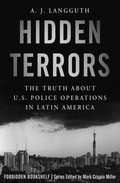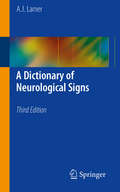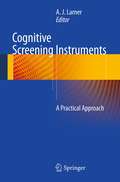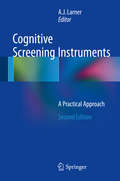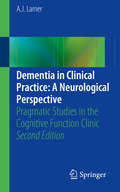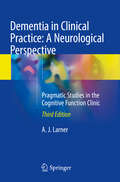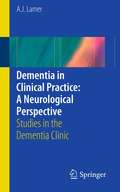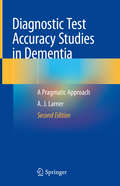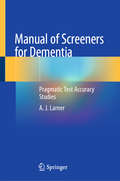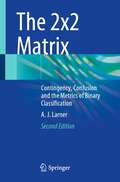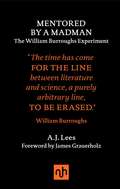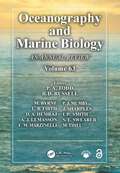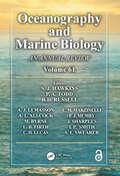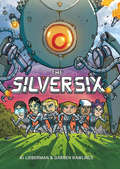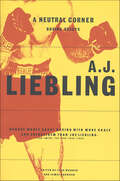- Table View
- List View
Hidden Terrors: The Truth About U.S. Police Operations in Latin America (Forbidden Bookshelf #27)
by A. J. LangguthA &“devastating&” exposé of the United States&’ Latin American policy and the infamous career and assassination of agent Dan Mitrione (Kirkus Reviews). In 1960, former Richmond, Indiana, police chief Dan Mitrione moved to Brazil to begin a new career with the United States Agency for International Development. During his ten years with the USAID, Mitrione trained and oversaw foreign police forces in extreme counterinsurgency tactics—including torture—aimed at stomping out communism across South America. Though he was only a foot soldier in a larger secret campaign, he became a symbol of America&’s brutal interventionism when he was kidnapped and executed by Tupamaro rebels in Montevideo, Uruguay. In Hidden Terrors, former New York Times Saigon bureau chief A. J. Langguth chronicles with chilling detail Mitrione&’s work for the USAID on the ground in South America and Washington, DC, where he shared his expertise. Along the way, Langguth provides an authoritative overview of America&’s efforts to destabilize communist movements and prop up military dictators in South America, presenting a &“powerful indictment of what the United States helped to bring about in this hemisphere&” (The New York Times). Even today, the tactics Mitrione helped develop continue to influence operations in Guantanamo Bay, Cuba, and black sites around the globe.
Our Vietnam: The War 1954-1975
by A. J. LangguthWinner of the Overseas Press Club's Cornelius J. Ryan Award for Best Nonfiction Book, the Commonwealth Club of California's Gold Medal for Nonfiction, and the PEN Center West Award for Best Research NonfictionTwenty-five years after the end of the Vietnam War, historian and journalist A. J. Langguth delivers an authoritative account of the war based on official documents not available earlier and on new reporting from both the American and Vietnamese perspectives. In Our Vietnam, Langguth takes us inside the waffling and deceitful White Houses of Kennedy, Johnson, and Nixon; documents the ineptness and corruption of our South Vietnamese allies; and recounts the bravery of soldiers on both sides of the war. With its broad sweep and keen insights, Our Vietnam brings together the kaleidoscopic events and personalities of the war into one engrossing and unforgettable narrative.
Patriots: The Men Who Started the American Revolution
by A. J. LangguthWith meticulous research and page-turning suspense, Patriots brings to life the American Revolution—the battles, the treacheries, and the dynamic personalities of the men who forged our freedom.George Washington, John Adams, Samuel Adams, Ben Franklin, Thomas Jefferson, Patrick Henry—these heroes were men of intellect, passion, and ambition. From the secret meetings of the Sons of Liberty to the final victory at Yorktown and the new Congress, Patriots vividly re-creates one of history's great eras.
Union 1812
by A. J. LangguthBy the author of the acclaimed Patriots: The Men Who Started the American Revolution, a gripping narrative that tells the story of the second and final war of independence that secured the nation's independence from Europe and established its claim to the entire continent. The War of 1812 has been ignored or misunderstood. Union 1812 thrillingly illustrates why it must take its place as one of the defining moments in American history.
A Dictionary of Neurological Signs, 4th Edition: Clinical Neurosemiology
by A. J. LarnerThis updated and expanded Fourth Edition is an alphabetical listing of commonly presenting neurological signs designed to guide the physician toward the correct clinical diagnosis. The dictionary is focused, problem-based and concise. <P><P> The structured entries in this practical, clinical resource provide summaries of a wide range of neurological signs. Each entry includes: a definition of the sign; a brief account of the clinical technique required to elicit the sign; a description of the other signs which may accompany the index sign; an explanation of pathophysiological and/or pharmacological background; differential diagnosis; brief treatment details; and where known, the neuroanatomical basis of the sign. <P><P> A Dictionary of Neurological Signs, Fourth Edition, is an indispensable reference for all students, trainees, and clinicians who care for patients with neurological disorders, and could also be used in preparation for exams, since each entry is a snapshot of a specific disorder or disease.
A Dictionary of Neurological Signs, Third Edition
by A. J. LarnerThe first two editions of the Dictionary of Neurological Signs were very well-received by readers and reviewers alike. Like those editions, this Third Edition, updated and expanded, can be almost as well described in terms of what the book is not, along with details about what it is. The Dictionary is not a handbook for treatment of neurological disorders. While many entries provide the latest treatment options, up-to-the-minute therapies are not discussed in bedside level detail. The Dictionary is not a board review book because it is not in Q&A format but could easily serve in that capacity since each entry is a fairly complete snapshot of a specific disorder or disease. The Dictionary is an alphabetical listing of commonly presenting neurological signs designed to guide the physician toward the correct clinical diagnosis. The Dictionary is focused, problem-based, concise and practical. The structured entries in this practical, clinical resource provide a thumbnail of a wide range of neurological signs. Each entry includes: * A definition of the sign * A brief account of the clinical technique required to elicit the sign * A description of the other signs which may accompany the index sign * An explanation of pathyophysiological and/or pharmacological background * Differential diagnosis * Brief treatment details Where known, these entries also include the neuroanatomical basis of the sign. The Dictionary of Neurological Signs, Third Edition, is an indispensable reference for all students, trainees, and clinicians who care for patients with neurological disorders.
Cognitive Screening Instruments: A Practical Approach
by A. J. LarnerCognitive Screening Instruments: A Practical Approach provides a practical and structured overview of some of the most commonly used and easily available cognitive screening instruments applicable in the outpatient clinic and bedside setting. Dementia and cognitive disorders are now recognised as an increasing public health problem, both in terms of patient numbers and cost, as populations age throughout the world. Despite this, many patients with dementia never receive a formal diagnosis, with implications for their appropriate care and management. Diagnostic tests which identify cases of dementia therefore have an important role. Expert authors from around the world equip the reader of Cognitive Screening Instruments: A Practical Approach with clear instructions on the usage of each screening instrument, its strengths and weaknesses, the time required for administration, and rules on scoring, such as how to correct for variations in the patient's age or education, and suggested cut-off scores. Cognitive Screening Instruments: A Practical Approach is a handy, illustrated guide and a valuable diagnostic aid for practitioners working closely with patients with dementia and mild cognitive impairment. This volume will be of use both to clinicians and to professionals in disciplines allied to medicine who are called upon to assess patients with possible cognitive disorders, including neurologists, old age psychiatrists, neuropsychologists, primary care physicians, dementia support workers, and members of memory assessment teams.
Cognitive Screening Instruments: A Practical Approach
by A. J. LarnerCognitive Screening Instruments: A Practical Approach provides a practical and structured overview of some of the most commonly used and easily available cognitive screening instruments applicable in the outpatient clinic and bedside setting. Dementia and cognitive disorders are now recognised as an increasing public health problem, both in terms of patient numbers and cost, as populations age throughout the world. Despite this, many patients with dementia never receive a formal diagnosis, with implications for their appropriate care and management. Diagnostic tests which identify cases of dementia therefore have an important role. Expert authors from around the world equip the reader of Cognitive Screening Instruments: A Practical Approach with clear instructions on the usage of each screening instrument, its strengths and weaknesses, the time required for administration, and rules on scoring, such as how to correct for variations in the patient's age or education, and suggested cut-off scores. Cognitive Screening Instruments: A Practical Approach is a handy, illustrated guide and a valuable diagnostic aid for practitioners working closely with patients with dementia and mild cognitive impairment. This volume will be of use both to clinicians and to professionals in disciplines allied to medicine who are called upon to assess patients with possible cognitive disorders, including neurologists, old age psychiatrists, neuropsychologists, primary care physicians, dementia support workers, and members of memory assessment teams.
Dementia in Clinical Practice: Pragmatic Studies in the Cognitive Function Clinic
by A. J. LarnerThis concise, pragmatic, pocket-sized book addresses neurological contributions to the diagnosis and management of dementia through a longitudinal examination of the work undertaken in a dedicated neurological dementia clinic. <P><P> It covers the use of cognitive and non-cognitive screening instruments and their diagnostic utility and the use of other diagnostic investigations: neuroimaging, neurophysiology and neuropathology. The diagnostic mix is discussed in terms of both neuropsychological syndromes and neurological diagnoses, as is the use of conventional treatments for dementia and the impact of national directives (e.g. NICE, National Dementia Strategy) on day-to-day clinical practice. <P> Dementia in Clinical Practice: A Neurological Perspective, Second Edition is an illustrated, practical resource for medical professionals involved in the assessment and management of dementia patients. It is of particular benefit to neurologists, psychiatrists, geriatricians, primary care practitioners and those working in the fields of neuropsychology, psychology, occupational therapy, speech and language therapy and nursing.
Dementia in Clinical Practice: Pragmatic Studies in the Cognitive Function Clinic
by A. J. LarnerThis expanded, updated third edition summarizes the pragmatic diagnostic accuracy studies of neurological signs and cognitive and non-cognitive screening instruments undertaken in the author’s clinic in the context of day-to-day practice involving patients with cognitive disorders including dementia. A new chapter devoted to comparing and combining instruments is included, and illustrative case studies have been included where relevant. Dementia in Clinical Practice: A Neurological Perspective, Third Edition is a practical resource for medical professionals involved in the assessment and management of patients with dementia and cognitive disorders. It may be of particular interest to neurologists, psychiatrists, geriatricians, primary care practitioners and those working with patients with cognitive impairment in the fields of neuropsychology, psychology, occupational therapy, speech and language therapy and nursing.
Dementia in Clinical Practice: Studies in the Dementia Clinic
by A. J. LarnerDementia in Clinical Practice: A Neurological Perspective addresses neurological contributions to the diagnosis and management of dementia through a longitudinal examination of the work undertaken in dedicated neurological dementia clinics. This concise, pragmatic handbook covers: The use of cognitive screening instruments and their diagnostic utility. The use of non-cognitive (functional, behavioural, neurovegetative) screening instruments and their diagnostic utility. The use of other diagnostic investigations: neuroimaging, neurophysiology, neuropathology. The diagnostic mix in terms of both neuropsychological syndromes and neurological diagnoses. The use of conventional treatments for dementia. The impact of national directives (e.g. NICE, National Dementia Strategy) on day-to-day clinical practice. Dementia in Clinical Practice: A Neurological Perspective is an illustrated, practical resource for medical professionals involved in the assessment and management of dementia patients. It is of particular benefit to neurologists, psychiatrists, geriatricians, primary care practitioners and those working in the fields of neuropsychology, psychology, occupational therapy, speech and language therapy and nursing.
Diagnostic Test Accuracy Studies in Dementia
by A. J. LarnerThis book explains the key steps in planning and executing diagnostic test accuracy studies in dementia, with clear explanations of difficulties and pitfalls and with jargon clearly explained. The emphasis is on pragmatic diagnostic test accuracy studies which can be integrated into day-to-day clinical practice. The book is based on the author's experience over more than 10 years, which has resulted in the publication of many diagnostic test accuracy studies. The text is structured as for a research publication on a diagnostic test accuracy study (Introduction, Methods, Results, Discussion), with a final chapter on Future Prospects. Each of the chapters is devoted to a practical and structured overview of each of these steps in performing and writing up such a study. Diagnostic Test Accuracy Studies in Dementia: A Pragmatic Approach is aimed at any clinician with an interest in dementia disorders: old age psychiatrists, geriatricians, neurologists, neuropsychologists and primary care physicians, as well as other professions allied to medicine. The book is also of interest to any clinician/researcher with an interest in diagnostic test accuracy studies.
Diagnostic Test Accuracy Studies in Dementia: A Pragmatic Approach
by A. J. LarnerThe new and updated edition of this book explains the key steps in planning and executing diagnostic test accuracy studies in dementia, serving as an introduction to the topic with clear explanations of difficulties and pitfalls. It has been fully revised in light of developments over the past 5 years and includes STARD publications which have appeared since the first edition as well as the use of biomarkers of cognitive disorders as increasingly enshrined in diagnostic criteria. The book covers the presentation of study results in terms of measures of discrimination, taking examples from studies in dementia looking at various diagnostic methods including cognitive instruments, neuroimaging, and biochemical studies. The book continues to reflect the author’s own experience in diagnostic test accuracy studies, particularly in the sphere of cognitive screening instruments..Diagnostic Test Accuracy Studies in Dementia encourages clinicians to adopt a pragmatic approach to diagnostic test accuracy studies rooted in day-to-day clinical practice.
Manual of Screeners for Dementia: Pragmatic Test Accuracy Studies
by A. J. LarnerThis book draws on the author’s experience in conducting pragmatic test accuracy studies on screening instruments for dementia/mild cognitive impairment. To facilitate comprehension and assimilation, all data is presented in an easily accessible, succinct and user-friendly way by means of a structured tabular format that allows tests to be easily compared. The pragmatic design of studies ensures high external validity and generalizability for the test results. The book includes a wealth of data on previously presented studies, as well as hitherto unreported test measures (“Number needed” metrics). It presents recently described and new diagnostic metrics (Likelihood to be diagnosed or misdiagnosed; Summary utility index; Number needed for screening utility); data from new studies on screeners (Attended with sign; Free-Cog; Two question depression screener; Jenkins Sleep Questionnaire; Triple test); and previously unpublished data (combination of SMC Likert and MACE; IADL Scale and MMSE). Given its scope, the book will be of interest to all professionals, beginners and seasoned experts alike, whose work involves the assessment of individuals with cognitive (memory) complaints.
Neuropsychological Neurology
by A. J. LarnerEssential to the management of patients suffering from neurological disorders is an understanding of the cognitive aspects of these conditions. This book begins with an outline of the various cognitive domains and how they can be tested, before covering in depth the cognitive deficits seen not only in prototypical neurodegenerative cognitive disorders (Alzheimer's disease, frontotemporal dementias, Huntington's disease, prionoses), but also in other common neurological disorders which may be complicated by cognitive impairment (stroke, multiple sclerosis, Parkinson's disease, brain tumours). This book is an essential reference text for all neurologists, not just those with an interest in cognitive disorders; and for general physicians and specialists who deal with any endocrine, metabolic, vascular, or infective disorders which may compromise cognitive function. Practitioners of professions allied to medicine which involve contact with cognitively impaired patients will also find this text useful.
Teleneurology by Internet and Telephone
by A. J. LarnerMedical information is now widely available on the Internet and through telephone helplines such as NHS Direct and the focus on patient self care is likely to increase. Clinicians in all specialties will often encounter patients who have made self-directed searches for medical information prior to the clinical encounter. Teleneurology by Internet and Telephone is a study of patient information-seeking behaviour in neurology patients prior to referral from primary to secondary care. The book analyses frequency of Internet access and use, and of telephone helpline awareness and use. It also explores use of these modalities over time, use according to patient gender and age and by gender and age over time. Teleneurology by Internet and Telephone is an accessible overview of the utility of these modalities of health information provision and will be of interest not only to neurologists and clinicians in other specialities but also to public health researchers, sociologists and political scientists with an interest in questions of health care provision.
The 2x2 Matrix: Contingency, Confusion and the Metrics of Binary Classification
by A. J. LarnerThis book describes, extends, and illustrates the metrics of binary classification through worked examples.Worked examples based on pragmatic test accuracy study data are used in chapters to illustrate relevance to day-to-day clinical practice. Readers will gain an understanding of sensitivity and specificity and predictive values along with many other parameters.The contents are highly structured, and the use of worked examples facilitates understanding and interpretation.This book is a resource for clinicians in any discipline who are involved in the performance or assessment of test accuracy studies and professionals in the disciplines of machine learning or informatics wishing to gain insight into clinical applications of 2x2 tables.
Transient Global Amnesia
by A. J. LarnerThis brief, accessible book covers all aspects of transient global amnesia (TGA). First, it deals with the history of TGA before moving on to clinical and diagnostic features, and differential diagnosis. The investigation and management of TGA is then discussed, followed by treatment and prognosis. Each of the chapters is devoted to a practical and structured overview of the particular topic, with use of case studies to illustrate the material. Based in part on the author's experience of TGA cases over 15 years and in part on a review of the published literature, this book will hopefully enlighten clinicians from a broad range of medical backgrounds on the clinical features, investigation, and pathogenesis of TGA. Transient Global Amnesia is aimed at any clinician with an interest in, or who encounters patients with, acute amnesia: neurologists, general physicians, old age psychiatrists, geriatricians, clinical neuropsychologists, and primary care physicians, as well as other professions allied to medicine with similar interests, such as members of memory assessment teams.
The Rice Trade in Asia (Routledge Studies in the Modern History of Asia)
by A. J. LathamThis book analyses the development of the rice trade in Asia since 1945.This book focuses on the three historically important exporters Myanmar, Thailand, and Vietnam and the two key importers Indonesia and the Philippines. The book addresses the impacts of several major transitions during this period on the rice trade in these nations, namely their initial recovery post-war, the political turbulence during and following the independence struggles of these nations, and the impact of the Vietnam war. It also tracks the fluctuating impact of the various El Nino/ Southern Oscillation (ENSO) climatic events across the period on harvest and exports, for example in events such as the rice crisis of 1973-75.Using data from the London Rice Brokers’ Association Circular to create a detailed narrative of the rice trade, this book will be of interest to students and scholars of Asian history, economic history and economic development in post-war Asia.
Mentored by a Madman: The William Burroughs Experiment
by A. J. Lees James GrauerholzA fascinating account by one of the world's leading neurologists of the profound influence of William Burroughs on his medical career. Lees relates how Burroughs, author of Naked Lunch and troubled drug addict, inspired him to discover a ground-breaking treatment for Parkinson's Disease. Lees journeys to the Amazonian rainforest in search of cures, and through self-experimentation seeks to find the answers his patients crave. He enters a powerful plea for the return of imagination to medical research.
Oceanography and Marine Biology: An Annual Review (Oceanography and Marine Biology - An Annual Review)
by L. B. Firth I. P. Smith S. E. Swearer P. A. Todd M. Thiel B. D. Russell A. J. Lemasson M. Byrne E. M. Marzinelli P. J. Mumby J. Sharples D. A. HemrajThe ever-increasing interest in work in oceanography and marine biology and its relevance to global environmental issues, especially global climate change and its impacts, creates a demand for authoritative refereed reviews summarising and synthesising the results of both historical and recent research. Oceanography and Marine Biology: An Annual Review continues to answer that need after six decades of publication.Volume 63 features a review of the factors affecting resilience and recovery of the coral reefs of the Andaman Sea, a systematic review of the 2014-2016 Northeast Pacific marine heatwave, an exploration of coexisting mangrove-coral habitats, a discussion of the problems and solutions in European cephalopod fisheries, a dive into the aquaculture of Rabbit fishes, an examination of how historical land reclamation and coastal urbanisation continue to shape Britain’s Ocean City and, finally, an examination of transferable stressors in small cetaceans.An international Editorial Board ensures global relevance and expert peer review, with editors from Australia, Denmark, Hong Kong, Ireland, Singapore and the UK. The series volumes find a place in the libraries of not only marine laboratories and oceanographic institutes but also universities worldwide. Three of the seven peer-reviewed contributions in Volume 63 are available to read Open Access via the webpage and on OAPEN.Supplementary material is provided online on the Support Materials tab for Reviews 1, 2, 3, 5, 6 and 7.Chapters 1, 2 and 7 of this volume are freely available as a downloadable Open Access PDF at http://www.taylorfrancis.com under a Creative Commons [Attribution-Non Commercial-No Derivatives (CC-BY-NC-ND)] 4.0 license.
Oceanography and Marine Biology: An Annual Review, Volume 62 (ISSN)
by L. B. Firth I. P. Smith A. L. Allcock S. E. Swearer P. A. Todd M. Thiel B. D. Russell A. J. Lemasson M. Byrne C. H. Lucas E. M. Marzinelli P. J. Mumby J. SharplesOceanography and Marine Biology: An Annual Review remains one of the most cited sources in marine science and oceanography. The ever-increasing interest in work in oceanography and marine biology and its relevance to global environmental issues, especially global climate change and its impacts, creates a demand for authoritative refereed reviews summarising and synthesising the results of both historical and recent research.If you are interested in submitting a review for consideration for publication in OMBAR, please email the new co-Editors in Chief, Dr Peter Todd (dbspat@nus.edu.sg) and Dr Bayden Russell (brussell@hku.hk).Supplementary material is provided online on the Support Materials tab, for Reviews 2, 5, 6, 7, 8, 9 and 10.Volume 62 features a review of the biology, ecology and conservation threats to the Iberian harbour porpoise; a look at the potential risk to Mediterranean cetaceans and sea turtles from floating marine macro litter; an overview of the recent history and physical environment of corals in the Andaman Sea; an exploration of the population biology of Snapper fish in South Australia; and a review of historical killings of small cetaceans in the Northeast Atlantic and Mediterranean Sea, among others.An international Editorial Board ensures global relevance and expert peer review, with editors from Australia, Canada, Hong Kong, Ireland, Singapore and the UK. The series volumes find a place in the libraries of not only marine laboratories and oceanographic institutes but also universities worldwide. Chapters 1, 2, 4, 6, 8 and 9 of this volume are freely available as a downloadable Open Access PDF at http://www.taylorfrancis.com under a Creative Commons [Attribution-Non Commercial-No Derivatives (CC-BY-NC-ND)] 4.0 license.
Oceanography and Marine Biology: An annual review. Volume 61 (Oceanography and Marine Biology - An Annual Review #61)
by S. J. Hawkins L. B. Firth I. P. Smith A. L. Allcock S. E. Swearer P. A. Todd B. D. Russell A. J. Lemasson M. Byrne C. H. Lucas E. M. Marzinelli P. J. Mumby J. SharplesOceanography and Marine Biology: An Annual Review remains one of the most cited sources in marine science. The increasing interest in work in oceanography and marine biology and its relevance to global environmental issues, especially global climate change and its impacts, creates a demand for authoritative refereed reviews summarising and synthesising the results of both historical and recent research. For more than 50 years, OMBAR has been an essential reference for researchers, students and workers in all fields of marine science. An international Editorial Board ensures global relevance and expert peer review, with editors from Australia, Hong Kong, Ireland, Singapore, and the UK. The series of volumes can be found in the libraries of institutes and universities worldwide.Five of the seven peer-reviewed contributions in Volume 61 are available to read Open Access via this webpage and on OAPEN. Supplementary material is provided online on the Support Materials tab on the book’s www.routledge.com webpage for Reviews 1, 2, 4, 5 and 6.. Volume 61 features a review of 100 years of daily sea surface temperature from the Hopkins Marine Station in Pacific Grove, California; an exploration of the biology and life cycle of enigmatic crustacean y-larvae; a review of the science, policy and management of the Central and South Atlantic Deep Sea benthos; a review of the biodiversity of the Irish-Scottish continental margin; an investigation of how new molecular tools can be used for marine biodiversity and ecosystem assessments, and a look at the resilience of marine organisms to climate change. A final monograph considers enemy shells as refugia from grazing and competition pressure. If you are interested in submitting a review for consideration for publication in OMBAR, please email the new co-Editors in Chief, Dr Peter Todd (dbspat@nus.edu.sg) and Dr Bayden Russell (brussell@hku.hk). Guidelines for contributors to OMBAR, including information on illustration requirements, can be downloaded on the "Support Material" tab on the latest volume’s webpage.
The Silver Six: A Graphic Novel
by A. J. LiebermanA group of orphans on the run search for a new home among the stars.When a group of orphans are thrown together under mysterious circumstances, Phoebe and her pal Oliver lead them in a daring escape from their orphanage to an uninhabited moon. But their idyllic paradise is shattered when the powerful corporate boss who ordered the deaths of their parents sends a relentless henchman to track them down. Now, with nowhere left to turn and time running out, Phoebe and her friends decide there's only one thing left to do: Fight back!
A Neutral Corner: Boxing Essays
by A. J. LieblingA Neutral Corner collects fifteen previously unpublished boxing pieces written by legendary sportswriter A.J. Liebling between 1952 and 1963.Demonstrating A.J. Liebling's abiding passion for the "sweet science" of boxing, A Neutral Corner brings together previously unpublished material. Antic, clear-eyed, and wildly entertaining, these essays showcase a The New Yorker journalist at the top of his form. Here one relives the high drama of the classic Patterson-Johansson championship bout of 1959, and Liebling's early prescient portrayal of Cassius Clay's style as a boxer and a poet is not to be missed.Liebling always finds the human story that makes these essays appealing to aficionados of boxing and prose alike. Alive with a true fan's reverence for the sport, yet balanced by a true skeptic's disdain for sentiment, A Neutral Corner is an American treasure.
